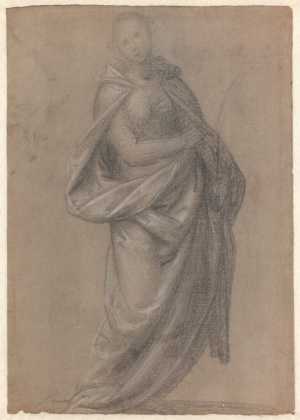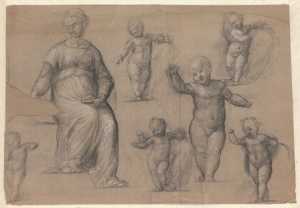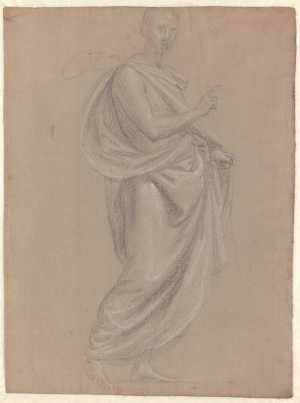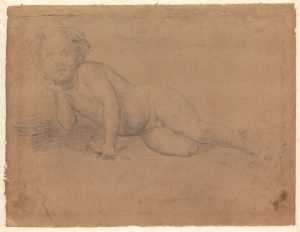Fra Bartolommeo is one of the most illustrious artists of the Italian High Renaissance. Born Bartolommeo di Paolo, he was also called Baccio della Porta. On entering the Dominican Order in 1500 he became Fra Bartolommeo (fra is the abbreviation of the Italian frate, or brother), the name by which he is best known today. After completing his training in the workshop of a Florentine artist, Fra Bartolommeo established himself independently in Florence, where he worked in collaboration with Mariotto Albertinelli for several years. Early in his career he found inspiration in the work of other artists in the city, notably Leonardo da Vinci, whose chiaroscuro—the use of light and shade to suggest space—had a lasting impact on his work. Fra Bartolommeo painted predominantly biblical subjects for churches and other religious institutions. Many of his projects were in Tuscany but he also worked in Ferrara, Venice and Rome. An inventory of his estate drawn up after his death includes 830 drawings and twelve books of sketches.
Fra Bartolommeo prepared his paintings meticulously by making sketches before starting to paint. For many artists, studies of this kind were purely functional. They were not intended to be works in their own right and most were discarded once they had served their purpose. Fra Bartolommeo, however, kept all his drawings in his studio. As a result, this collection remained largely intact and was later passed down from one generation to the next. In 1727 the Florentine collector Francesco Maria Niccolò Gabburri bought a large group of Fra Bartolommeo’s drawings from a convent in Florence. A few years later he had them mounted in two ornate, leather-bound albums, respectively marked M and N. He filled a third album, marked B, with landscape drawings he had acquired separately, as works by Andrea del Santo, but which are now attributed to Fra Bartolommeo. The collection was split up after Gabburri’s death. The albums marked M and N were acquired by distinguished private collectors like Sir Thomas Lawrence and King William II of the Netherlands, and ultimately found their way into the collection of Franz Koenigs, which came to Museum Boymans in 1935. The sheets were removed from the albums in 1988/90 to make it easier to preserve and exhibit them.
The museum has a substantial number of Fra Bartolommeo´s surviving drawings. Totalling 493, including 8 drawings by unidentified pupils, they are executed on 389 sheets (104 of which are double-sided), and mostly rendered in black or red chalk, or both. They include composition drawings and studies of figures and figure groups, as well as heads and limbs. The majority were preparatory studies for altarpieces or other projects, mostly depicting religious subjects. They give a good impression of the artist’s working methods and his efficiency, creativity and ingenuity. After sketching a complete composition, he would work out the figures and groups in separate studies, sometimes using a grid to transfer the drawings to scale on to his canvas or panel. For studies of clothed figures and portaits he occasionally worked from living models, in most cases his fellow friars or workshop assistants. For studies of postures and draperies he generally used the two mannikins ('manchini' in Italian), one of which was life-size according to Giorgio Vasari (in his 'Vite', 1550/68). The albums also contain 12 sheets with 5 drawings by Mariotto Albertinelli, 1 by Fra Paolino da Pistoia and 9 by Giovanni Antonio Sogliani. The total number of drawings in the albums is 505 on 401 sheets (104 of which are double-sided).
[text: Albert Elen]

Fra Bartolommeo (Bartolomeo-Domenico di Paolo del Fattorino, Baccio della Porta)
Florence 1472/1474 - Florence 1517

















